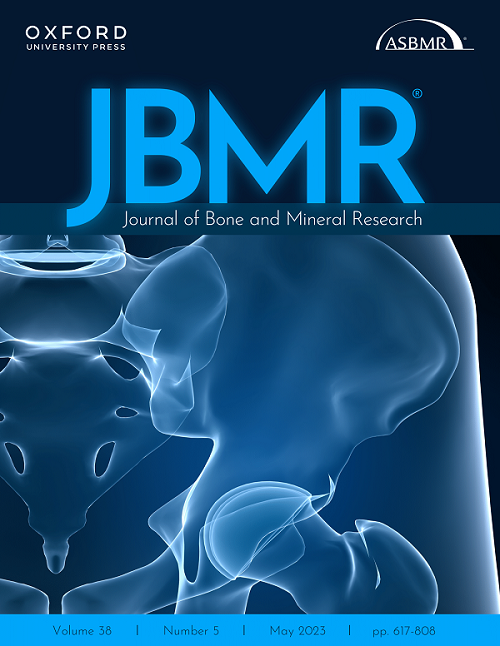Suzanne M Jan de Beur, Tricia Cimms, Annabel Nixon, Christina Theodore-Oklota, Diana Luca, Mary Scott Roberts, Shayna Egan, Christina A Graham, Elizabeth Hribal, Christopher J Evans, Sue Wood, Angela Williams
下载PDF
{"title":"Burosumab Improves Patient-Reported Outcomes in Adults With Tumor-Induced Osteomalacia: Mixed-Methods Analysis","authors":"Suzanne M Jan de Beur, Tricia Cimms, Annabel Nixon, Christina Theodore-Oklota, Diana Luca, Mary Scott Roberts, Shayna Egan, Christina A Graham, Elizabeth Hribal, Christopher J Evans, Sue Wood, Angela Williams","doi":"10.1002/jbmr.4900","DOIUrl":null,"url":null,"abstract":"<p>Tumor-induced osteomalacia (TIO) is an ultra-rare disease caused by tumors that secrete fibroblast growth factor 23, leading to chronic hypophosphatemia, poor skeletal health, and impaired physical function. In a phase 2 trial (UX023T-CL201; NCT02304367; <i>n</i> = 14), 48 weeks of burosumab treatment restored phosphate homeostasis, with improvements in skeletal health, functional mobility, and patient-reported pain, fatigue, and health-related quality of life (HRQL) (SF-36 v2). Here, we report an exploratory mixed-methods analysis of change from baseline after 144 weeks of burosumab treatment alongside qualitative data from exit interviews with 8 of 14 trial participants to evaluate meaningful treatment effects from a patient perspective. The interview subset (<i>n</i> = 8) reported pain and fatigue and compromised HRQL at baseline. In the interviews, participants reported that compromised HRQL and pain were the most important aspects of the disease to treat; both were considered more bothersome than fatigue and compromised physical function and activities of daily living. Improvements in pain and fatigue after treatment were reported, some of which achieved statistically and/or clinically meaningful thresholds. Furthermore, improvements in SF-36 v2 scores were most pronounced in the Physical Component Score and its Physical Function and Bodily Pain domains. Overall, the interview subset provided descriptions of symptomatic improvement and its clinical meaningfulness, including physical function, participation in activities of daily living, and mental well-being. Thus, this exploratory mixed-methods analysis provides deeper understanding of patients' perception of clinical meaningfulness beyond that articulated in validated patient-reported outcome instruments. © 2023 The Authors. <i>Journal of Bone and Mineral Research</i> published by Wiley Periodicals LLC on behalf of American Society for Bone and Mineral Research (ASBMR).</p>","PeriodicalId":185,"journal":{"name":"Journal of Bone and Mineral Research","volume":"38 11","pages":"1654-1664"},"PeriodicalIF":5.1000,"publicationDate":"2023-08-14","publicationTypes":"Journal Article","fieldsOfStudy":null,"isOpenAccess":false,"openAccessPdf":"https://asbmr.onlinelibrary.wiley.com/doi/epdf/10.1002/jbmr.4900","citationCount":"0","resultStr":null,"platform":"Semanticscholar","paperid":null,"PeriodicalName":"Journal of Bone and Mineral Research","FirstCategoryId":"3","ListUrlMain":"https://onlinelibrary.wiley.com/doi/10.1002/jbmr.4900","RegionNum":1,"RegionCategory":"医学","ArticlePicture":[],"TitleCN":null,"AbstractTextCN":null,"PMCID":null,"EPubDate":"","PubModel":"","JCR":"Q1","JCRName":"ENDOCRINOLOGY & METABOLISM","Score":null,"Total":0}
引用次数: 0
引用
批量引用
Abstract
Tumor-induced osteomalacia (TIO) is an ultra-rare disease caused by tumors that secrete fibroblast growth factor 23, leading to chronic hypophosphatemia, poor skeletal health, and impaired physical function. In a phase 2 trial (UX023T-CL201; NCT02304367; n = 14), 48 weeks of burosumab treatment restored phosphate homeostasis, with improvements in skeletal health, functional mobility, and patient-reported pain, fatigue, and health-related quality of life (HRQL) (SF-36 v2). Here, we report an exploratory mixed-methods analysis of change from baseline after 144 weeks of burosumab treatment alongside qualitative data from exit interviews with 8 of 14 trial participants to evaluate meaningful treatment effects from a patient perspective. The interview subset (n = 8) reported pain and fatigue and compromised HRQL at baseline. In the interviews, participants reported that compromised HRQL and pain were the most important aspects of the disease to treat; both were considered more bothersome than fatigue and compromised physical function and activities of daily living. Improvements in pain and fatigue after treatment were reported, some of which achieved statistically and/or clinically meaningful thresholds. Furthermore, improvements in SF-36 v2 scores were most pronounced in the Physical Component Score and its Physical Function and Bodily Pain domains. Overall, the interview subset provided descriptions of symptomatic improvement and its clinical meaningfulness, including physical function, participation in activities of daily living, and mental well-being. Thus, this exploratory mixed-methods analysis provides deeper understanding of patients' perception of clinical meaningfulness beyond that articulated in validated patient-reported outcome instruments. © 2023 The Authors. Journal of Bone and Mineral Research published by Wiley Periodicals LLC on behalf of American Society for Bone and Mineral Research (ASBMR).

 求助内容:
求助内容: 应助结果提醒方式:
应助结果提醒方式:


